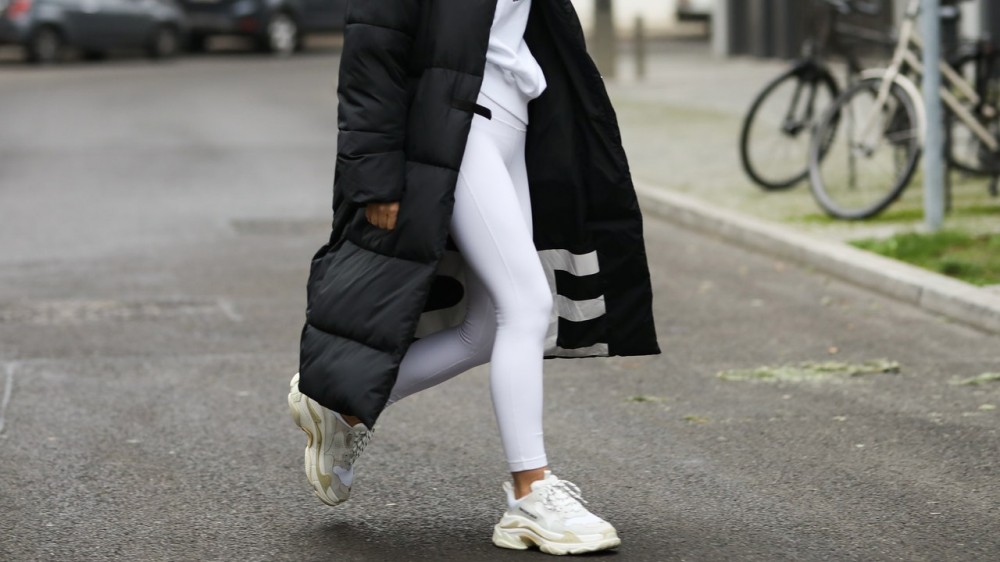
The Defining Look of 2020? Fracked Fashion
How will the pandemic change fashion? It’s the question we’ve been asking ourselves for nine months. Some of the answers out there are too general—that we’ll wear sweatpants forever or, conversely, dress up in sequins and heels every day. A more realistic prediction is that our clothes will become softer, more comfortable, and more versatile.
That will inevitably require some stretch. The retail analytics firm Edited has reported that brands are “easing customers back” into regular clothes by adding more stretch fabrics and elastic waists. Premium denim labels are swapping vintage-inspired rigid jeans for stretchy ones blended with polyester, spandex, and Lycra. We’re seeing the influence on the runways, too: In the recent spring 2021 collections, designers shot elastic through the waists of dresses, styled tuxedo jackets with track pants, and cut suits in performance jersey.
It isn’t a bad thing that our clothes are getting comfier. As my colleague Laird Borrelli-Persson pointed out, “history suggests that women are often most liberated in periods when clothes work with the body rather than create armor for it.” Natalie Kingham, the buying director for MatchesFashion.com, put it this way to Vogue’s Mark Holgate: “Fashion in 2020 is what makes us feel better, instead of dressing for approval from other people.”
Those are undeniably positive shifts. But the irony is that as fashion gets softer, stretchier, and more personal, it’s also getting further away from its sustainability goals. For years, the most basic thing a brand could do to reduce its environmental impact was phase out synthetic fibers like polyester, nylon, and elastane—all of which are derived from plastic, which is derived from oil. Yet most of our leggings, stretch jeans, and tech-y athleisure pieces are made of precisely those materials.
For the uninitiated, they start with fracking, followed by a series of chemical reactions to transform crude oil into a fiber. The fibers don’t biodegrade, which means a polyester legging may sit in a landfill for hundreds of years before eventually breaking into smaller and smaller microplastics. Those later contaminate the soil, harm wildlife, and enter our food and water. Washing polyester and other plastic-based synthetics in the laundry releases microplastics, too (including recycled polyester). You’ve heard the statistics, no doubt: that by 2050, there will be more plastic in the ocean than fish. But yesterday’s news is a real wakeup call: Researchers announced that microplastics have been found in the fetuses of unborn babies.
How can we reconcile our desire for comfort with these environmental and human downsides? It isn’t as easy as swapping synthetic fibers for natural ones; cotton and linen don’t exactly lend themselves to compression leggings, and a zip-up wool jacket doesn’t cut the same silhouette as it would in nylon. For those of us craving a softer look, there are some organic activewear labels out there, like Indigo Luna and Ceres, both premised on natural yoga and workout gear. In lieu of polyester, Indigo Luna’s signature legging comes in hand-dyed organic cotton, while Ceres’s is a waffle-textured cotton. Still, some stretch is unavoidable; both leggings include a small percentage of spandex or elastane to give them flexibility and shape. There are a few glimmers of hope: Dupont and Lycra are developing bio-based stretch made of corn or plant sugars, and Adam Taubenfligel, cofounder of the denim label Triarchy, recently developed the first plastic-free stretch jeans with the Italian mill Candiani. A few years ago, Triarchy dropped its entire assortment of stretch denim in a move to become plastic-free; that meant every jean was 100% organic, non-stretch cotton.
“As a ‘sustainable brand,’ it felt a bit hypocritical to offer stretch denim,” he explains. “But it really restricted our ability to tap into a big part of the market.” Taubenfligel worked closely with Candiani to figure out the best natural alternative to Spandex or polyester, eventually landing on natural rubber. After a few rounds of sampling, they found an ideal balance: 96% organic cotton, 4% rubber. Taubenfligel called it a “game-changer” for his business: “This is what we’ve all been waiting for.”
That rubber-stretch denim is available to any of Candiani’s clients, not just Triarchy. The hope is that other brands will buy it and take the concept mainstream. “The more brands that adopt the fabric, the cheaper it will become, and we can just replace plastic completely.” It’s easy to imagine how it might apply to other garments, like leggings or workout gear, which is almost always synthetic. Taubenfligel says rubber isn’t an ideal solution for activewear, since it needs a fiber to bind to like cotton or linen, which aren’t ideal for sweat, and binding it to polyester or nylon would miss the point. But he’s confident that more natural options are coming. “It explains why a company as big as Lululemon hasn’t done it yet,” he says. “But at some point, there will be a solution.”
It could take years, if not decades, to develop and scale natural alternatives to polyester, Spandex, and other synthetics. But until then, we should be as thoughtful about our activewear and other fracked fabrics as we are about plastic cups and straws. The New Standard Institute points out that without legislation and industry collaboration, the plastic industry will only continue to grow—in fact, by 2050, the production of new plastic is expected to quadruple. “We need a binding global treaty for the reduction of plastic generation and production,” NSI writes. “While that may take time to negotiate, we can start by demanding brands stem the flow of plastic production.”
It’s worth checking the garment tags on everything you buy; even a sweater that feels like wool might actually be blended with synthetics for added softness. If you’re in the market for activewear, recycled materials are still an improvement on virgin polyester: Girlfriend Collective and Adidas by Stella McCartney both use 100% recycled polyester and nylon, and Brooklyn designer Suzie Kondi is developing a recycled plastic fiber with Bionic Yarn to use for her groovy tracksuits. She knows it isn’t the perfect solution, but as her brand grows rapidly—her sales tripled, then quadrupled this spring—her environmental impact is increasing, too. “We’re focusing on creatively tying together our business with ethical partners across the industry,” Kondi says. “We want to pivot against the greenwashing that’s all too common in the industry, [and] take our customer on this journey with us and be an educational resource.”
Education will be key. Most consumers haven’t connected the dots between fracking and fashion, largely due to a lack of transparency from brands. But as demand for athleisure and loungewear explodes—the active market is expected to reach $547 billion by 2024, with loungewear rising to $19.5 billion—that awareness is arguably more important than ever. Fortunately, this isn’t a difficult one to wrap your head around. As NSI bluntly put it: “You’re wearing plastic.”


